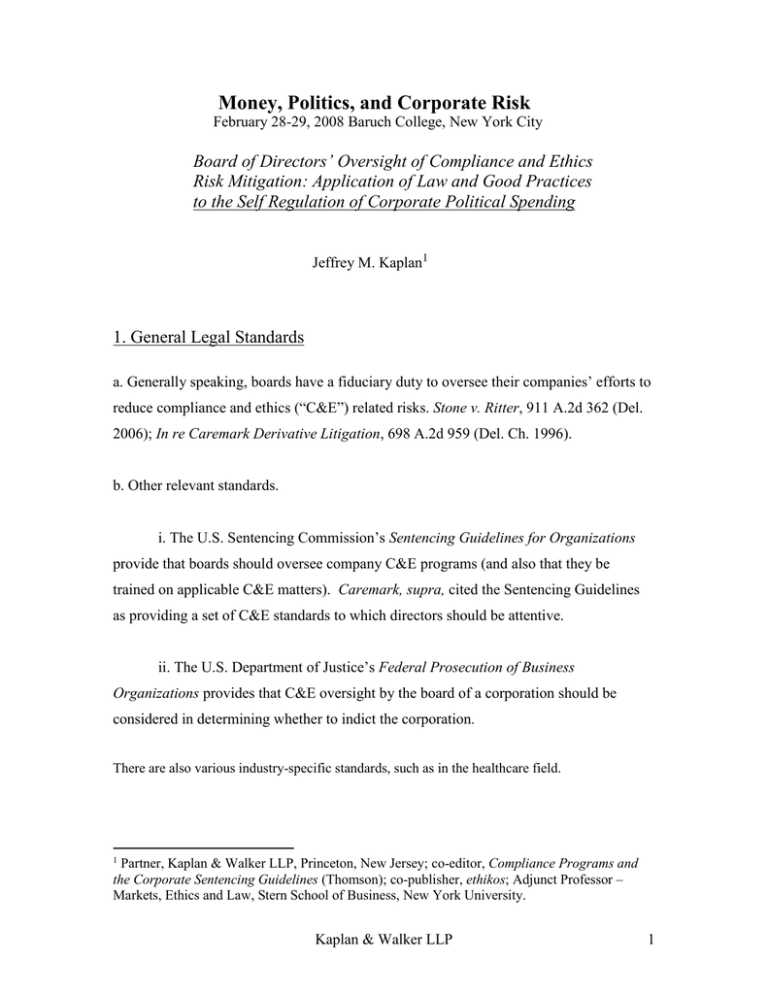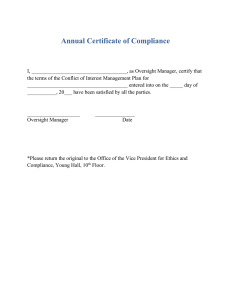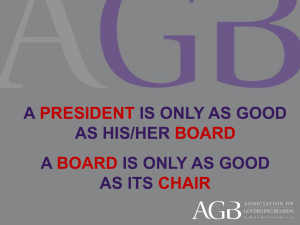Money, Politics, and Corporate Risk
advertisement

Money, Politics, and Corporate Risk February 28-29, 2008 Baruch College, New York City Board of Directors’ Oversight of Compliance and Ethics Risk Mitigation: Application of Law and Good Practices to the Self Regulation of Corporate Political Spending Jeffrey M. Kaplan1 1. General Legal Standards a. Generally speaking, boards have a fiduciary duty to oversee their companies’ efforts to reduce compliance and ethics (“C&E”) related risks. Stone v. Ritter, 911 A.2d 362 (Del. 2006); In re Caremark Derivative Litigation, 698 A.2d 959 (Del. Ch. 1996). b. Other relevant standards. i. The U.S. Sentencing Commission’s Sentencing Guidelines for Organizations provide that boards should oversee company C&E programs (and also that they be trained on applicable C&E matters). Caremark, supra, cited the Sentencing Guidelines as providing a set of C&E standards to which directors should be attentive. ii. The U.S. Department of Justice’s Federal Prosecution of Business Organizations provides that C&E oversight by the board of a corporation should be considered in determining whether to indict the corporation. There are also various industry-specific standards, such as in the healthcare field. 1 Partner, Kaplan & Walker LLP, Princeton, New Jersey; co-editor, Compliance Programs and the Corporate Sentencing Guidelines (Thomson); co-publisher, ethikos; Adjunct Professor – Markets, Ethics and Law, Stern School of Business, New York University. Kaplan & Walker LLP 1 2. Good Practices a. Boards generally delegate C&E oversight to a board committee - typically audit or governance. See Berenbeim and Kaplan, Ethics Programs – the Role of the Board: A Global Study (The Conference Board 2004). b. Board C&E oversight is generally not as involved as is that of management. For instance, under the Sentencing Guidelines, management should “ensure that the organization has an effective” C&E program (emphasis supplied). By contrast, boards have a somewhat lesser obligation, which is to “be knowledgeable about the content and operation of the [C&E] program and [to] exercise reasonable oversight with respect to the implementation and effectiveness of the …program.” But, boards should – and sometimes do – play a relatively strong oversight role where, from a risk mitigation perspective, this can be particularly helpful to a company. (See #2d, below.) c. Boards tend to meet their oversight responsibilities in three ways: i. Receiving information about general aspects of the C&E program, such as the operation of the helpline or training employees on the code of conduct. ii. Receiving information about mitigation of high risk areas. E.g., in Stone v Ritter, supra, a bank’s board regularly received information about the bank’s anti-money laundering (“AML”) compliance program, which helped the board avoid liability in a suit brought by the bank’s shareholder arising from AML compliance failures. iii. Receiving information about C&E issues concerning senior management. d. Two factors are generally relevant to determining the nature and extent of a board’s oversight of a particular C&E risk area: Kaplan & Walker LLP 2 i. The degree of risk – in terms of legal liability or reputational harm - of that area; and ii. The importance of independent oversight vis a vis effective compliance for that area. E.g., in the area of Foreign Corrupt Practices Act compliance (which is somewhat analogous to regulating corporate political spending), some boards exercise a relatively significant amount of oversight, because i) the impact of a violation is generally high; but ii) for business reasons, managements may be resistant to implementing strong C&E measures. 3. Application of general C&E oversight standards to self regulation of corporate political spending – the need for strong board oversight a. The above-mentioned factors suggest a need for relatively strong oversight by boards in the area of corporate political spending, for two reasons. b. First, a violation seems reasonably likely to have a significant negative impact. i. This is generally more in terms of reputational impact than through the direct costs of incurring legal liability, but it can still constitute a meaningful level of risk. ii. Reputation risks will be particularly significant for certain types of entities: A. Regulated businesses (e.g., energy utilities). B. Entities that sell to governmental bodies (a category which obviously covers a wide range of industries). C. Perhaps to a lesser extent, companies selling to consumers. (The possibility of a negative business impact arising from C&E violations vis a vis consumers Kaplan & Walker LLP 3 seems likely to grow more significant with time, as consumers become more focused on corporate ethics issues generally.) D. Entities with prior problems of this type. c. Second, the nature of the risk suggests the need for independent oversight, i.e., that failing to oversee management’s implementation of a corporate political spending policy would not be prudent. This is because: i. The interests of individual managers in making political contributions may differ from that of the company as an entity; and ii. Managers may not have the type of expertise in the political realm that they do in traditional areas of business, suggesting less of a basis for deferring to their decisions than elsewhere. d. Additionally, the Center for Political Accountability (“CPA”) study Open Windows: How Codes of Conduct Regulate Corporate Political Spending found that, in 34 Fortune 100 companies, boards have some oversight of this risk area (according to a review of such companies’ web sites and codes of conduct). This is a relatively high number for C&E risk-area oversight, suggesting that boards themselves see the need for strong oversight of corporate political spending. 4. Suggested means of board oversight of corporate political spending: self regulatory efforts a. Delegate responsibility for overseeing the company’s policy on political contributions to a board committee. The committee should be comprised of independent directors. b. The committee’s mandate could include the following: i. Initial review of a company’s: Kaplan & Walker LLP 4 A. Code of conduct/policy provision on corporate political spending for comprehensiveness, clarity and general efficacy as a basis for reducing risk in this area (CPA model code is an obvious place to start); and B. Procedures for pre-approval of political spending and controls to ensure compliance. ii. Receive reports on actual expenditures. A. Note that the committee should question the reports, among other things, as to the sufficiency of the corporate purpose of the expenditures, and also seek assurance that no expenditure was made in consideration of an official act. I. Some boards require prior approval of expenditures, although this is presumably the minority approach. B. Each board will need to determine how frequently it receives such reports, based in part on its degree of risk in this area. iii. Receive an annual report from the company official with responsibility for administering the policy on the following: A. Looking over the past year, the committee should review: I. The efficacy of the means to communicate the code/policy provision to intended recipients. II. The efficacy of the means to gather information necessary for disclosures under the policy (to ensure that they are well designed to capture all the pertinent information). Kaplan & Walker LLP 5 III. Any issues of non-compliance that have arisen under the policy. B. Looking to the future, any factors suggesting a need to modify the: I) Policy and/or II) Plans/procedures to promote the policy in the coming year. iv. Receive periodic audits of requirements under the policy of: a) Mandated prior management-level approval of contributions. b) Accuracy of disclosures. Note that these steps are offered as a general approach and that a board might wish to do more or less depending on the nature of a given company’s risks. Kaplan & Walker LLP 6


